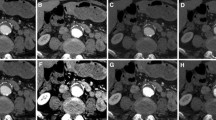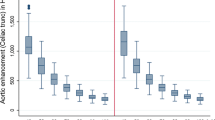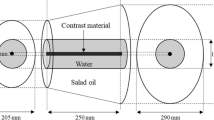Abstract
Objectives
To compare quantitative image quality parameters in abdominal dual-energy computed tomography angiography (DE-CTA) using an advanced image-based (Mono+) reconstruction algorithm for virtual monoenergetic imaging and standard DE-CTA.
Methods
Fifty-five patients (36 men; mean age, 64.2 ± 12.7 years) who underwent abdominal DE-CTA were retrospectively included. Mono + images were reconstructed at 40, 50, 60, 70, 80, 90 and 100 keV levels and as standard linearly blended M_0.6 images (60 % 100 kV, 40 % 140 kV). The contrast-to-noise ratio (CNR) and signal-to-noise ratio (SNR) of the common hepatic (CHA), splenic (SA), superior mesenteric (SMA) and left renal arteries (LRA) were objectively measured.
Results
Mono+ DE-CTA series showed a statistically superior CNR for 40, 50, 60, 70 and 80 keV (P < 0.031) compared to M_0.6 images for all investigated arteries except SMA at 80 keV (P = 0.08). CNR at 40 keV revealed a mean relative increase of 287.7 % compared to linearly blended images among all assessed arteries (P < 0.001). SNR of Mono+ images was consistently significantly higher at 40, 50, 60 and 70 keV compared to M_0.6 for CHA and SA (P < 0.009).
Conclusions
Compared to linearly blended images, Mono+ reconstructions at low keV levels of abdominal DE-CTA datasets significantly improve quantitative image quality.
Key Points
• Mono+ combines increased attenuation with reduced image noise compared to standard DE-CTA.
• Mono+ shows superior contrast-to-noise ratios at low keV compared to linearly-blended images.
• Contrast-to-noise ratio in monoenergetic DE-CTA peaks at 40 keV.
• Mono+ reconstructions significantly improve quantitative image quality at low keV levels.





Similar content being viewed by others
References
Vlahos I, Chung R, Nair A, Morgan R (2012) Dual-energy CT: vascular applications. AJR 199:87–97
Brockmann C, Jochum S, Sadick M et al (2009) Dual-energy CT angiography in peripheral arterial occlusive disease. Cardiovasc Intervent Radiol 32:630–637
Huang SY, Nelson RC, Miller MJ et al (2012) Assessment of vascular contrast and depiction of stenoses in abdominopelvic and lower extremity vasculature: comparison of dual-energy MDCT with digital subtraction angiography. Acad Radiol 19:1149–1157
Sommer WH, Johnson TR, Becker CR et al (2009) The value of dual-energy bone removal in maximum intensity projections of lower extremity computed tomography angiography. Invest Radiol 44:285–292
Stolzmann P, Frauenfelder T, Pfammatter T et al (2008) Endoleaks after endovascular abdominal aortic aneurysm repair: detection with dual-energy dual-source CT. Radiology 249:682–691
Yu L, Leng S, McCollough CH (2012) Dual-energy CT-based monochromatic imaging. AJR 199:9–15
Apfaltrer P, Sudarski S, Schneider D et al (2014) Value of monoenergetic low-kV dual energy CT datasets for improved image quality of CT pulmonary angiography. Eur J Radiol 83:322–328
Schneider D, Apfaltrer P, Sudarski S et al (2014) Optimization of kiloelectron volt settings in cerebral and cervical dual-energy CT angiography determined with virtual monoenergetic imaging. Acad Radiol 21:431–436
Sudarski S, Apfaltrer PW, Nance J et al (2013) Optimization of keV-settings in abdominal and lower extremity dual-source dual-energy CT angiography determined with virtual monoenergetic imaging. Eur J Radiol 82:574–581
Maturen KE, Kaza RK, Liu PS, Quint LE, Khalatbari SH, Platt JF (2012) “Sweet spot” for endoleak detection: optimizing contrast to noise using low keV reconstructions from fast-switch kVp dual-energy CT. J Comput Assist Tomogr 36:83–87
Bamberg F, Dierks A, Nikolaou K, Reiser MF, Becker CR, Johnson TRC (2011) Metal artifact reduction by dual energy computed tomography using monoenergetic extrapolation. Eur Radiol 21:1424–1429
Zhou C, Zhao YE, Luo S et al (2011) Monoenergetic imaging of dual-energy CT reduces artifacts from implanted metal orthopedic devices in patients with factures. Acad Radiol 18:1252–1257
Grant KL, Flohr TG, Krauss B, Sedlmair M, Thomas C, Schmidt B (2014) Assessment of an advanced image-based technique to calculate virtual monoenergetic computed tomographic images from a dual-energy examination to improve contrast-to-noise ratio in examinations using iodinated contrast media. Invest Radiol 49:586–592
Schabel C, Bongers M, Sedlmair M et al (2014) Assessment of the hepatic veins in poor contrast conditions using dual energy CT: evaluation of a novel monoenergetic extrapolation software algorithm. Rofo 186:591–597
Wichmann JL, Majenka P, Beeres M et al (2014) Single-portal-phase low-tube-voltage dual-energy CT for short-term follow-up of acute pancreatitis: evaluation of CT severity index, interobserver agreement and radiation dose. Eur Radiol 24:2927–2935
Guimarães LS, Fletcher JG, Harmsen WS et al (2010) Appropriate patient selection at abdominal dual-energy CT using 80 kV: relationship between patient size, image noise, and image quality. Radiology 257:732–742
Sigal-Cinqualbre AB, Hennequin R, Abada HT, Chen X, Paul J-F (2004) Low-kilovoltage multi-detector row chest CT in adults: feasibility and effect on image quality and iodine dose. Radiology 231:169–174
Szucs-Farkas Z, Kurmann L, Strautz T, Patak MA, Vock P, Schindera ST (2008) Patient exposure and image quality of low-dose pulmonary computed tomography angiography: comparison of 100- and 80-kVp protocols. Invest Radiol 43:871–876
Szucs-Farkas Z, Verdun FR, von Allmen G, Mini RL, Vock P (2008) Effect of X-ray tube parameters, iodine concentration, and patient size on image quality in pulmonary computed tomography angiography: a chest-phantom-study. Invest Radiol 43:374–381
Wichmann JL, Nöske E-M, Kraft J et al (2014) Virtual monoenergetic dual-energy computed tomography: optimization of kiloelectron volt settings in head and neck cancer. Invest Radiol 49:735–741
Leschka S, Stolzmann P, Schmid FT et al (2008) Low kilovoltage cardiac dual-source CT: attenuation, noise, and radiation dose. Eur Radiol 18:1809–1817
Schueller-Weidekamm C, Schaefer-Prokop CM, Weber M, Herold CJ, Prokop M (2006) CT angiography of pulmonary arteries to detect pulmonary embolism: improvement of vascular enhancement with low kilovoltage settings. Radiology 241:899–907
Delesalle M-A, Pontana F, Duhamel A et al (2013) Spectral optimization of chest CT angiography with reduced iodine load: experience in 80 patients evaluated with dual-source, dual-energy CT. Radiology 267:256–266
Carrascosa P, Capunay C, Rodriguez-Granillo GA, Deviggiano A, Vallejos J, Leipsic JA (2014) Substantial iodine volume load reduction in CT angiography with dual-energy imaging: insights from a pilot randomized study. Int J Cardiovasc Imaging 8:1613–1620
Raju R, Thompson AG, Lee K et al (2014) Reduced iodine load with CT coronary angiography using dual-energy imaging: a prospective randomized trial compared with standard coronary CT angiography. J Cardiovasc Comput Tomogr 8:282–288
Meinel FG, Canstein C, Schoepf UJ et al (2014) Image quality and radiation dose of low tube voltage 3rd generation dual-source coronary CT angiography in obese patients: a phantom study. Eur Radiol 24:1643–1650
Gordic S, Husarik DB, Desbiolles L, Leschka S, Frauenfelder T, Alkadhi H (2014) High-pitch coronary CT angiography with third generation dual-source CT: limits of heart rate. Int J Cardiovasc Imaging 30:1173–11
Acknowledgments
The scientific guarantor of this publication is Dr. Julian L. Wichmann. The authors of this manuscript declare relationships with the following companies: Ralf W. Bauer is on the speakers' bureau of Siemens Healthcare, Computed Tomography division. The other authors of this manuscript declare no relationships with any companies whose products or services may be related to the subject matter of the article. The authors state that this work has not received any funding. One of the authors has significant statistical expertise. Institutional review board approval was obtained. Written informed consent was waived by the institutional review board. Approval from the institutional animal care committee was not required because animal subjects were not included in this study. No study subjects or cohorts have been previously reported. Methodology: retrospective, case–control study, performed at one institution.
Author information
Authors and Affiliations
Corresponding author
Rights and permissions
About this article
Cite this article
Albrecht, M.H., Scholtz, JE., Hüsers, K. et al. Advanced image-based virtual monoenergetic dual-energy CT angiography of the abdomen: optimization of kiloelectron volt settings to improve image contrast. Eur Radiol 26, 1863–1870 (2016). https://doi.org/10.1007/s00330-015-3970-2
Received:
Revised:
Accepted:
Published:
Issue Date:
DOI: https://doi.org/10.1007/s00330-015-3970-2




